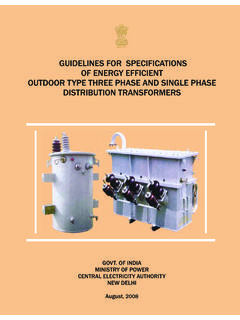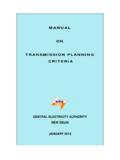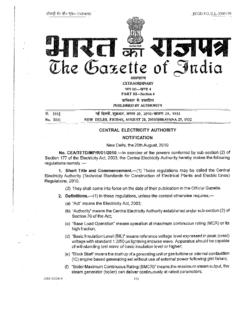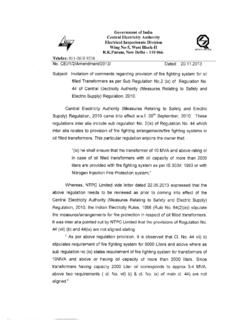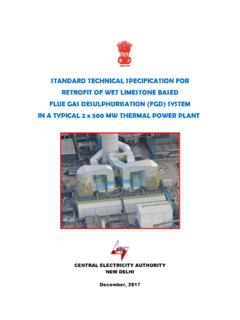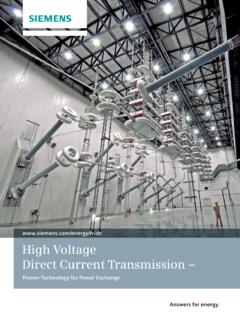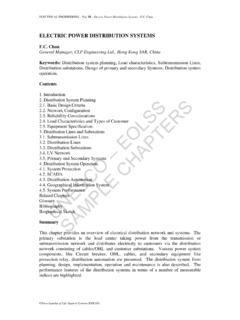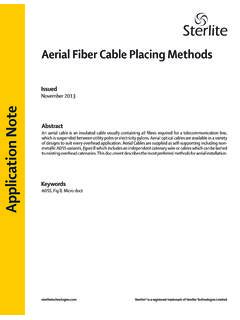Transcription of GUIDELINES FOR USE OF UNDER GROUND CABLE SYSTEM …
1 Page 1 of 13 GUIDELINES FOR USE OF UNDER GROUND CABLE SYSTEM AND overhead CONDUCTOR SYSTEM ALONG WITH COST BENEFIT ANALYSIS CENTRAL ELECTRICITY AUTHORITY 2018 Page 2 of 13 1. INTRODUCTION distribution of electricity involves the transfer of electrical energy from one electric substation to another electrical substation ( like from 220/33 KV S/S to 33/11 KV S/S and 33/11 KV S/S to 11 KV distribution Transformer S/S etc) through sub-transmission and distribution lines. These lines may be overhead lines or underground cables. Each of the two types has its benefits as well as demerits. The choice of overhead Network or underground network depends on many factors like safety requirement, Right of way, cost ,aesthetic look and other factors.
2 Despite being expensive, underground cables have several advantages over OH lines. These are mostly used where safe clearances for overhead Network is not available as well as in densely populated areas where overhead Network cannot be used., whereas, overhead Network is cheaper, easy to install/upgrade and easy to attend the fault etc. a. overhead NETWORK In overhead power lines, a structure based network is used to transmit electrical energy from one point to another. It consists of adequate size of conductors , commonly three conductor in 66 KV , 33 KV or 11 KV lines or four conductor in 11 KV lines or 5 conductor in LT lines ( 5th conductor for street lighting) for three phase lines and two conductors for single phase lines etc suspended by towers or poles and generally comprising of the items- such as Poles, Conductors, Cross arms, pin insulators, Stay Wires, Stay Rod, Stay Anchor, Guy Insulator, earthing materials, Guard wire, Barbed wire and Danger plate etc The Poles for the electrical network may be a Steel Poles (Tubular Poles, Rolled Steel Joists and Rails)
3 ,Concrete Poles (RCCP oles,PCC poles and Pre-Stressed Concrete -PSC) Pole) of various heights of 9 meters to 13 meters (IS: 5613 (Part 1, 2, 3) depending on site location, minimum safety clearance and Voltage (230 Volts, 415 Volts, 11KV and 33KV etc) of the overhead network SYSTEM . Along with these poles, Rail poles, which have more strength then other poles, are generally used in overhead network along and across the Road, Public Places, Residential areas, River crossing etc. Sometimes, for supporting different voltages on the same poles and to maintain the adequate clearance between the different lines of different voltage levels, poles with higher heights are used, and in such cases, guard wires are also provided to prevent Page 3 of 13 accidental over charging of lines of lower voltage SYSTEM due to conductor snapping etc.
4 The conductors for the overhead network can be a bare conductor or an insulated conductor ( ABC) depending on the requirement. It is an important component of overhead electrical transmission and distribution systems. The choice of conductor depends on the power carrying capacity, cost, growth of the load, and reliability & efficiency. While selecting an ideal conductor, some of the following features such as -i) maximum electrical & thermal capacity and cost effectiveness etc are considered. As per CEA(Technical Standards for construction of Electrical Plants and Electric Lines) regulations 2010, as amended upto date, adequate capacity AAC (All Aluminium Conductor), AAAC (All Aluminum Alloy Conductor), ACSR (Aluminum Conductor Steel Reinforced), ACAR (Aluminum Conductor, Aluminum Reinforce) or any new technology higher current carrying conductors (AL-59, HLTS etc) may be used in sub transmission and distribution SYSTEM .
5 Since, the insulations between the conductors is provided by air, overhead power lines are generally the lowest-cost method of power transmission for large quantities of electric energy from one point to another. In addition to above types of bare conductors, Insulated conductors (Aerial Bunched cables) may also be used in overhead network SYSTEM . The use of Aerial Bunched Cables (ABC) is a good concept for overhead power LT distribution where the Page 4 of 13 electrical clearance is not available or where theft is there. When compared with the overhead distribution SYSTEM with conventional bare conductors, ABC provides higher safety and reliability and SYSTEM economy by reducing theft in the area of installation.
6 This SYSTEM is ideal for rural distribution and especially attractive for installation in difficult terrains such as hilly areas, forest areas, coastal areas etc. Aerial Bunched Cables is also considered to be the best choice for power distribution in congested urban areas with narrow lanes and by-lanes. Some other advantages of use of ABC are- ABC provide safety to human life when used in congested area and narrow lane areas. ABC provides flexibility to use multiple circuits of different voltages strung on the same set of poles without using separate poles. ABC provides better adaptability to run concurrently with other overhead SYSTEM with bare conductor and also with communication lines without any interference.
7 ABC provides insulation resistance to earth in all seasons and negligible leakage of currents and thereby, the low losses of leakage. ABC is unaffected by pollution in the atmosphere. ABC, at the same time also reduces the theft of energy as it can not be tapped it prevents the use of illegal hooks etc on LT lines in the theft prone areas and helps to improve the AT&C losses of the SYSTEM . b. underground NETWORK In UNDER GROUND CABLE SYSTEM , the power is transferred from one point to another through underground cables laid in the GROUND in place of overhead lines on poles/ towers. As these cables are not exposed to the air/ atmosphere, this makes the U/G cabling SYSTEM less susceptible to outages due to various atmospheric conditions like high wind, storm, thunder storms, heavy snow or ice storms etc.
8 As these cables are not visible on GROUND , these provide an aesthetic look to the area where these are laid as compare to OH lines. However, the U/G cables have to be laid in the proper tranches and also have more restoration time in case of any fault as compare to OH lines. Page 5 of 13 While selecting the rating of cables to be used, some of the parameters such as Current carrying capacity, Voltage drop and short circuit rating are important factors to select the economical and optimum size of CABLE . The CABLE generally comprises of the conductor, insulation material, bedding, beading/ armoring, and outer sheath etc. Although, the armoring and outer sheath takes care of the physical safety of CABLE , adequate care has to be taken by CABLE manufactures during manufacturing of the CABLE .
9 Normally the lifespan of a CABLE is about 40 to 50 years. But over the time, the insulation of CABLE may get damaged or weakened due to ageing. Wrong handling of cabals, such as damages due to wrong handling/laying of CABLE also weakens the insulation of the cables. Normally, some of CABLE faults may be as- 1. a short circuit fault between two conductor due to failure of insulation between the two conductors 2. a earth fault, , fault between conductor and GROUND due to failure of outer insulation sheath 3. an open circuit fault, caused due to disconnection of the conductor etc. The choice of whether to use overhead line (OHL) or underground CABLE (UGC) must be made keeping in view the safety, reliability and operational choice between OHL and UGC is driven by technical, environmental and economic considerations.
10 Page 6 of 13 2. COMPARISON OF UG SYSTEM AND OH SYSTEM - FEASIBILITY ANALYSIS Feasibility study of overhead and underground line on various points is classified below : i. COST OF INSTALLATION underground network installation is more expensive than OH lines , since the cost of cables include CABLE charges along with road restoration charges which make the per unit coat of U/G cabling SYSTEM several times greater than overhead SYSTEM . ii. FAULT LOCATION IDENTIFICATION & REPAIRING TIME The identification of fault finding and repairing on overhead wire is easy as compare to UG cables as UG cables are buried in the GROUND and it require specialized techniques to find out the fault location as compare to OH lines.


